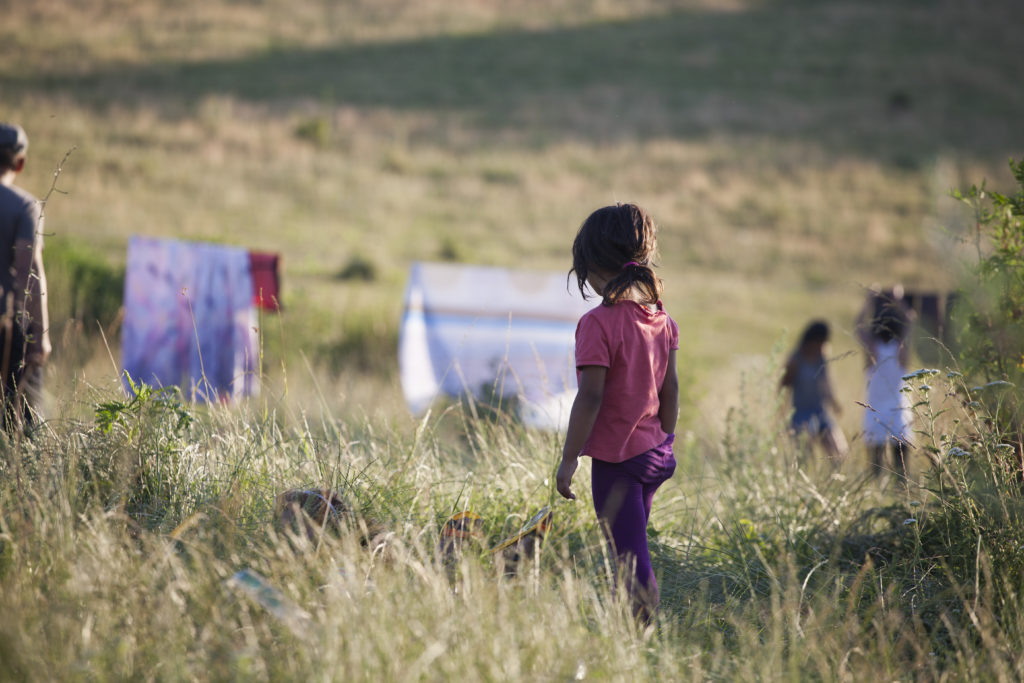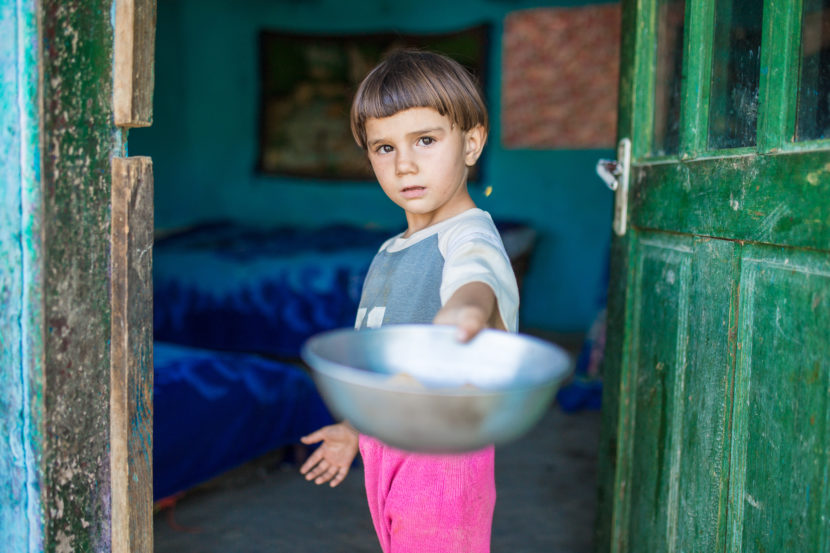According to a recent report, one child out of four is at risk of child poverty and social exclusion in Europe. The pandemic and subsequent lockdowns, followed by and coupled with the ongoing cost-of-living crisis, have exposed and exacerbated inequalities, increasing the number of children at risk. In this context, children from four European countries have provided a definition of poverty which encompasses “lack of money” and “lack of basic resources”, but also “sadness” and “abnormality”. This report proves how children are the experts of their condition and why they have to be taken into account in matters affecting them.
The unsettling truth of child poverty in Europe
According to the latest data from Eurostat for 2022, 24.7 percent (almost 20 million) of children in Europe are at risk of poverty and social exclusion (Eurochild, October 2023). Compared with 2021, this share slightly increased by 0.3 percentage points. At the national level, in 2022, the highest values were reported in Romania (41.5 percent), Bulgaria (33.9 percent) and Spain (32.2 percent). In contrast, Slovenia (10.3 percent), Czechia (13.4 percent), and Denmark (13.8 percent) registered the lowest shares (Eurostat, 2023).
The pandemic and subsequent lockdowns, followed by and coupled with the ongoing cost-of-living crisis, have exposed and exacerbated inequalities, plunging many children and families, particularly those from vulnerable backgrounds, deeper into poverty and further into social exclusion. The detrimental impact of poverty on the health, education and overall development and well-being of children cannot be overstated (Eurochild Report, 2023).
With these premises, a recent report tried to capture how children view poverty and how they believe it affects their experiences at home, in school, in their community, and with their friends. The report was developed thanks to the contributions of 203 children coming from four countries: Bulgaria, Croatia, Estonia and Malta. The idea of the report was to put in children’s shoes to see things from their perspectives and to make sure their voices can be heard and used by decision-makers, to make sure that the changes children want to see can become a reality (Eurochild Report, 2023)
National views on child poverty: a comparative analysis
The countries surveyed and presented in Eurostat’s repost – Bulgaria, Croatia, Estonia, and Malta – reflect the range of child poverty in the European Union (EU). In Bulgaria, 33 percent of children (1.19 million) are at risk of poverty or social exclusion. This is above the current EU average of 24.4 percent. Malta is close to the EU average with 22.6 percent (82,130), the lowest rates in this report being found in Croatia with 18.4 percent (691,849) and Estonia with 17.4 percent (258,227).
The consultations with children across the four countries reflected various experiences across different socio-economic circumstances. For instance, the Maltese focus group focused more on the role of education in ending the stigma surrounding (child) poverty, whereas Bulgarian children highlighted the need for innovative awareness-raising measures.
In addition, Croatia focused on the importance of sufficient and affordable housing and promoted practical solutions to fight against poverty, such as by promoting fundraising campaigns and free school meals. Finally, the Estonian focus group highlighted the economic aspect of poverty, by emphasising the need for a minimum, sufficient income for all, as well as targeted financial support for families in poverty, including child support (Eurochild Report, 2023).
How do children define poverty?

For the adult world, poverty can be defined as people with low income (people at risk of poverty – AROP), people severely materially or socially deprived (people at risk of social exclusion – AROPE) or people living in a household with very low work intensity (AROPE, 2023). At the same time, children have a different definition of poverty.
Across all four countries, the children’s most common association when discussing the term “poverty” was primarily a lack of money, followed by a lack of basic resources and necessities, such as water, food, home or shelter, heating, and electricity. These understandings were accompanied by mentions of “harsh living conditions” in which children live and a general difficulty in going about one’s daily life (Eurochild Report, 2023).
“Poverty is the lack of something: some people are poor because they have no friends, others are poor in knowledge and so on. Most people would say that people who don’t have money are poor, but poverty isn’t just about our income.”
– a child from Malta (Eurochild Report, 2023)
The lack of something is not simply related to material things, but also to knowledge, relations and feelings. For instance, the link between the impact of poverty and the emotional aspect is quite strong. Several children from Croatia and Estonia echoed this relationship. A child from Estonia shared that being: “poor means lacking happiness from someone’s life”, with another adding that “poverty is a situation where you don’t have a person who can help you”. Similar responses were elicited from several children in Croatia, with two of them sharing that, for them, the term poverty is related to not having a family or to the feeling of sadness (Eurochild Report, 2023).
What are the consequences of poverty on children?
When children were asked about the effects on children and young people living in poverty, the most common reply was that they and their families would not have enough money to pay for things like food, heating, electricity or gas (Eurochild Report, 2023). The lack of material things is one of the first tangible elements of poverty that children perceive the most, especially during adolescence, when the social acceptance from a group of peers also includes dressing, speaking, and behaving in the same way as the others (Encyclopedia of Childrens Health, 2023).
Children may not have the financial resources to participate in the same social activities, even those as simple as “going out” with their peers, and for this reason, they could feel different to the other children (Eurochild Report, 2023).
For instance, bullying and/or being excluded by the group of peers was the second most identified impact of poverty on children, and the one which generated the most comments in the discussions, as well as there were remarks about the impact of bullying on the mental health of children. The most common explicit responses referred to feelings of constant worry, sadness and loneliness (Eurochild Report, 2023).
Moreover, the consultation demonstrated that children are aware of the long-term effects of poverty, and they suffer from their consequences. One of the children commented that: “[poverty] has a bad effect because then children can’t possibly discover their potential” or because “they can’t grow normally”. Another child from the same focus group added that: “children nowadays must learn to accept that you can’t have everything in life” – a statement that indicates that experiences of poverty can lead to fewer aspirations for some children (Eurochild Report, 2023).
School and home: the places of poverty experienced by children
The link between poverty and children can also be observed in some specific places and the report focused on two dimensions which pertain to children: school and home.
As regards school, it not only serves as a core part of a child’s socialisation and integration into their wider community, but it also has the potential to be a powerful vehicle of upward social mobility. Nevertheless, child poverty can also be felt as a significant barrier for children to reach their full potential in school environments. In fact, the consultation showed that poverty can make children targets of bullying and social exclusion in school (Eurochild Report, 2023).
Moreover, hidden educational costs related to the purchase of stationery, uniforms and books could hinder or obstacle children’s access to education. For instance, financial issues and poverty were identified by children in Malta and Estonia as factors hindering children’s ability to access online classes during the COVID-19 pandemic and especially during the periods of lockdown (Eurochild Report, 2023).
In the home environment, poverty manifests itself in very concrete terms. Children might be unable to afford to stay in their homes, and would either be evicted or forced to move, perhaps even regularly, or their quality of living would decrease, as their homes would be in a worse state, by being colder, humid, or without (warm) running water.
Children also shared that living in poverty can also translate into smaller accommodations leading to a complete lack of private spaces and thus moments of privacy. This “can often lead to a very bad atmosphere”, according to one child from Croatia. In each country consultation group, children identified the role of poverty as something that could contribute to tensions within the home environment, constant arguments, and children feeling anger toward their parents (Eurochild Report, 2023).
Communities as key players in combatting child poverty
The community children grow up in plays a fundamental role in shaping their development and well-being. Healthy relationships in the community can reinforce a sense of belonging. In contrast, isolation can reinforce feelings of alienation, impacting children’s sense of identity and self-worth (Eurochild Report, 2023).
In this sense, it is important to promote awareness of the root causes of poverty at any level and promote chances to fill the gap between children who live in poverty and others. All children should have access to the same opportunities, and they all have the right to develop personality, talents and mental and physical abilities to their fullest potential (Article 29 of the Convention on the Rights of the Child) (CRC, 2023).
Moreover, the report has the merit of proving how child participation is essential to policy discussions on all aspects that impact children’s lives. Their experiences and voices illustrate that children are experts in their own lives and that no one can understand their reality better than they can. Policymakers and the community as a whole have to involve children in the public debate on matters affecting them and support channels and platforms to do so.
“The underrepresentation of children’s voices in decision-making is still pervasive, especially in discussions related to child poverty. With our report, we put children’s perspectives under the spotlight because no one understands the lived experiences of children better than children themselves.”
– H.E. Marie-Louise Coleiro Preca, Eurochild President (Eurochild Report, 2023)

In this sense, Humanium is working continuously to advocate for the fight against the root causes of child poverty through its projects aimed at improving the lives of underprivileged children worldwide. If you would like to join us and support our work, consider making a donation, engaging in sponsorship, or even becoming a volunteer.
Written by Arianna Braga
References:
AROPE (2023). Glossary: At risk of poverty or social exclusion (AROPE). Retrieved from Eurostat at https://ec.europa.eu/eurostat/statistics-explained/index.php?title=Glossary:At_risk_of_poverty_or_social_exclusion_(AROPE), accessed on 10 November 2023.
CRC (2023). Convention on the Rights of the Child. Retrieved from OHCHR at https://www.ohchr.org/en/instruments-mechanisms/instruments/convention-rights-child, accessed on 10 November 2023.
Encyclopedia of Children’s Health (2023). Peer acceptance. Retrieved from Encyclopedia of Children’s Health at http://www.healthofchildren.com/P/Peer-Acceptance.html, accessed on 10 November 2023.
Eurochild (October 2023). Poverty takes away the right to childhood. Retrieved from Eurochild at https://eurochild.org/resource/poverty-takes-away-the-right-to-childhood/, accessed on 10 November 2023.
Eurostat (2023). 25% of children at risk of poverty or social exclusion in 2022. Retrieved from Eurostat at https://ec.europa.eu/eurostat/web/products-eurostat-news/-/ddn-20230927-1, accessed on 10 November 2023.


